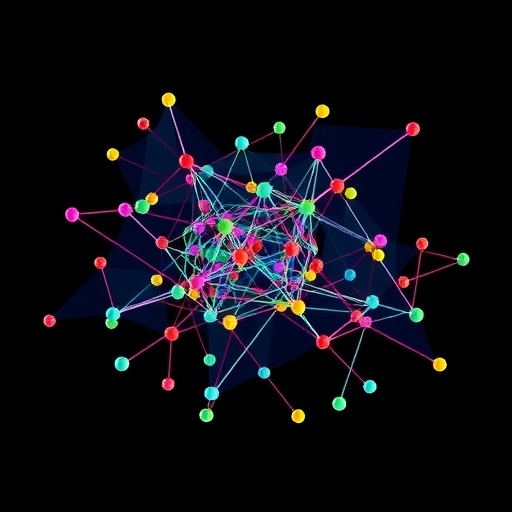In a groundbreaking study published in Nature Machine Intelligence, researchers Li, Zhang, and Wang et al. delve into the innovative realm of deep learning by introducing Kolmogorov–Arnold graph neural networks (KAGNNs) specifically designed for molecular property prediction. This research not only exemplifies the fusion of graph theory and machine learning but also addresses the pressing challenge of accurately predicting molecular properties, which is crucial for drug discovery, materials science, and various chemical applications.
The team’s exploration into KAGNNs is predicated on the understanding that conventional neural network architectures often fall short when handling the complex and interdependent nature of molecular data. Traditionally, molecular representations have relied heavily on simplified descriptors or unstructured data formats. In contrast, KAGNNs leverage the power of graphs to more effectively encode both the structural and functional characteristics of molecules. This mathematical framework affords an unprecedented level of detail in molecular representation, allowing for nuanced insights into their chemical behaviors and interactions.
At the core of their methodology, the researchers implemented a sophisticated scheme that draws on the principles of Kolmogorov’s work in probability theory and Arnold’s contributions to dynamical systems. By intertwining these concepts, the KAGNNs establish a potent mechanism for learning from graph-structured data. This includes utilizing nodes to represent atoms, edges to denote bonds, and the overall graph to encapsulate the entire molecular topology. Such a representation captures the intricate relationships between different molecular constituents, which is essential when predicting properties that rely on these interactions.
Moreover, the researchers meticulously evaluated their KAGNN framework against established machine learning methods, demonstrating superior performance in various predictive tasks. Through rigorous experimentation, they validated their model’s effectiveness in accurately forecasting molecular properties that have perplexed scientists for years. This advancement signals a pivotal shift in the approach to computational chemistry and material science, promising to enhance the efficiency and accuracy of molecular simulations and property predictions.
Furthermore, the inherent flexibility of the KAGNN architecture opens the door to numerous applications beyond mere property prediction, including reaction prediction, toxicity assessment, and even the design of new materials with desired features. This versatility is particularly significant in the realm of drug discovery, where the ability to predict how a molecule will interact with biological systems can drastically influence therapeutic outcomes. The implications of such a model are profound and could accelerate the development of new, life-saving medications.
In the age of data-driven discoveries, the integration of graph neural networks into molecular research aligns perfectly with the increasing availability of complex biological and chemical datasets. These datasets often contain a wealth of information that traditional analysis methods cannot fully harness. By effectively utilizing KAGNNs, researchers can extract deeper insights from these datasets, uncovering patterns and relationships that might otherwise remain hidden.
The precision of KAGNNs is not solely limited to predictive accuracy; it also encompasses interpretability, an important factor in scientific exploration. Understanding the ‘why’ behind a prediction is as critical as the prediction itself. By employing graph-based structures, the KAGNN framework allows researchers to trace back through the networks and identify which particular features contributed to a prediction. This feature not only enhances the model’s transparency but also fosters a deeper understanding of molecular behavior, paving the way for more informed experimental designs.
Additionally, the challenges associated with computational efficiency in molecular simulations are addressed through the KAGNN approach. The researchers acknowledge the computational demands of dealing with vast molecular datasets and propose that their model offers a more scalable solution. This scalability is vital for both academic research and industrial applications, as it enables the swift analysis of large datasets without compromising on the accuracy of predictions.
The KAGNN development marks a significant milestone in the intersection of chemistry and machine learning, reflecting a continuing trend towards more integrated approaches in scientific research. As machine learning becomes increasingly prevalent in various scientific fields, the necessity for advanced methodologies like KAGNNs becomes evident, especially in contexts where data complexity is king. The transition from traditional regressive models to graph-based neural networks symbolizes an evolution in how scientists approach molecular modeling.
This research holds immense promise for the future of computational chemistry. The KAGNN framework is a testament to how interdisciplinary collaboration can propel scientific understanding forward. By marrying graph theory with deep learning, the authors have forged a novel tool that enhances the predictive power of computational models, thereby addressing critical gaps that previously hindered progress in the field.
As we stand on the brink of a new era in molecular studies, propelled by advancements like the KAGNN, the excitement is palpable. Researchers worldwide will no doubt keenly observe the unfolding impact and applications of these findings as they work to integrate such methodologies into their own research techniques. The increasing sophistication of models like KAGNN will likely reshape the landscape of molecular property prediction and beyond, resonating throughout the fields of chemistry, biology, and materials science for years to come.
In conclusion, this research highlights the significance of innovation in scientific modeling, especially within the framework of molecular science. The Kolmogorov–Arnold graph neural networks serve not only as a representation of contemporary computational capabilities but also as a beacon of future possibilities. The findings underscore the necessity of exploring new methodologies in the quest for knowledge, ultimately driving forward an age of unprecedented scientific discovery.
Subject of Research: Molecular property prediction using Kolmogorov–Arnold graph neural networks.
Article Title: Kolmogorov–Arnold graph neural networks for molecular property prediction.
Article References:
Li, L., Zhang, Y., Wang, G. et al. Kolmogorov–Arnold graph neural networks for molecular property prediction.
Nat Mach Intell 7, 1346–1354 (2025). https://doi.org/10.1038/s42256-025-01087-7
Image Credits: AI Generated
DOI: https://doi.org/10.1038/s42256-025-01087-7
Keywords: Graph neural networks, molecular property prediction, machine learning, computational chemistry, KAGNNs, drug discovery, molecular simulations.
Tags: advanced methodologies in molecular modelingcomplex molecular data analysisdeep learning in chemistrydrug discovery using AIenhancing neural networks for chemistryfunctional characteristics of chemical compoundsGraph neural networks for molecular predictioninnovative applications of graph theoryKolmogorov-Arnold graph neural networksmachine learning in materials sciencemolecular property prediction techniquesstructural representation of molecules





